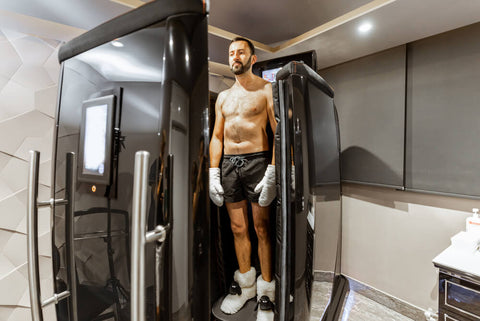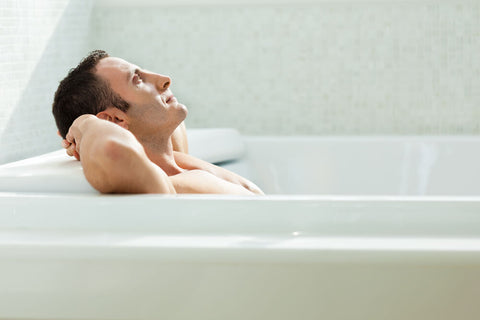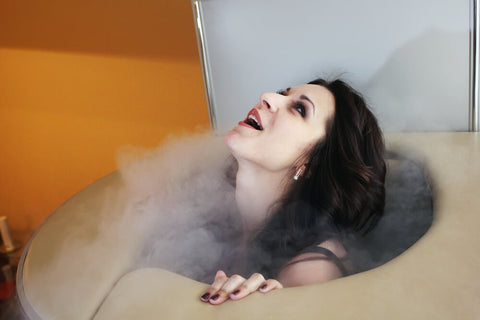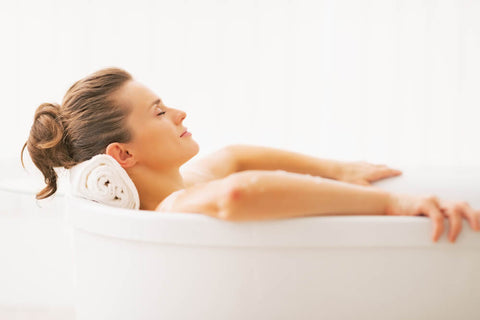
Cryotherapy vs. Ice Bath: Which is Better for You?
When it comes to post-workout recovery or injury management, the power of cold therapy is undeniable. Two popular cold therapy methods that have gained attention for their potential benefits are cryotherapy and ice baths. Which is better for you between the two? To make an informed decision, learn their key differences, similarities, benefits, and drawbacks.
Cryotherapy vs Ice Bath: Overview
Cryotherapy Basics

Cryotherapy or cold therapy is used to treat various physical and mental conditions by exposing your body to freezing temperatures. Whole-body cryotherapy typically involves standing in a chamber at temperatures ranging from -200°F to - 300°F for 2-4 minutes. The icy air triggers a response in your body, causing it to reduce inflammation, improve muscle recovery, improve antioxidant levels in the blood, and release adrenalin to enhance mood. Cryotherapy can be done in one area of the body, like the facial cryo, or for the whole body.
Ice Bath Basics

Ice bath, cold-water immersion (CWI), or cold plunge involves immersing your entire body in cold or icy water, usually around 50-59°F, for 10-20 minutes. This cold-water therapy provides a full-body experience that prompts your body to react similarly to cryotherapy, reducing inflammation and boosting mood. It also helps reduce muscle soreness, improve circulation, and provide a mental challenge to help build resilience and focus.
When comparing cryotherapy and ice baths, it is essential to consider the following factors:
- Temperature: Cryotherapy involves much colder temperatures than ice baths.
- Duration: Cryotherapy sessions are significantly shorter (2-3 minutes) than ice baths (10-20 minutes).
- Accessibility: Full-body cryotherapy requires specialized equipment and facilities, while ice baths can be easily set up at home with a tub filled with cold water and ice. Localized cryotherapy can be done using ice massage, ice packs, or coolant sprays.
Based on these significant differences, you can choose between cryotherapy and ice baths according to your comfort level and budget.
Temperature and Duration

Cryotherapy Temperature and Duration
In cryotherapy, the chamber temperature usually ranges from -140°F to -220°F. This extreme cold helps reduce inflammation and improve mood by releasing adrenaline and endorphins. During a cryotherapy session, you will be exposed to this cold environment, most likely without any wetness or dampness, as the process utilizes dry air.
The duration of a cryotherapy session is typically short—usually lasting around 2 to 3 minutes. Some individuals might find this more comfortable due to the lack of wetness and the brief treatment time.
However, since the temperature is so low, it needs to be precisely monitored by a therapist and limited in duration to ensure safety and effectiveness.
Ice Bath Temperature and Duration
For an ice bath, the water temperature should ideally hover around 50-60°F, which is cold enough to cause shivering but not as frigid as cryotherapy. This is because your body will be submerged in ice-cold water, penetrating your skin and causing an uncomfortable freezing sensation.
It's important to gradually build up your tolerance for ice baths. Initially, you should aim for two or three weekly sessions, each lasting 10 to 15 minutes.
However, remember that you'll need to incrementally increase your exposure, as jumping directly into long sessions could be dangerous and counterproductive.
Keep in mind the following points for both cryotherapy and ice baths:
- Always consult a professional or medical practitioner before starting cold therapy, as individual tolerance may vary.
- Monitor your body's reaction and adjust temperature and duration accordingly.
- Be cautious not to overdo it, as excessive exposure to cold temperatures can cause harm.
Following these guidelines will give you a safe and effective cold therapy experience.
Health Benefits of Ice Baths and Cryotherapy

1. Reduced Inflammation and Muscle Pain
Cryotherapy and ice baths can help significantly reduce inflammation and alleviate muscle pain. Exposing your body to freezing temperatures constricts blood vessels and minimizes muscle soreness.
2. Enhanced Recovery
Cold therapy promotes enhanced recovery in athletes and individuals seeking relief from muscle pain and tension. By reducing inflammation, improving circulation, and soothing localized soreness in the muscle tissue, your body is better prepared to heal and repair itself faster.
3. Mental and Emotional Benefits
Immersing yourself in cold water or a cryotherapy chamber can stimulate the production of endorphins, known as the "feel-good" hormones. These endorphins help reduce stress, anxiety, and feelings of depression. Moreover, some studies suggest that cold therapy can promote higher-quality sleep, further supporting mental well-being.
Additional Benefits of Cold Therapy
- Strengthening the immune system: Cold exposure can increase white blood cell production, helping to boost your immune system and protect against illness.
- Pain relief: Cold therapy may act as a natural pain reliever due to its numbing effect on sore muscles and joints.
- Skin improvement: Decreased inflammation and increased antioxidant levels could improve skin health, treat atopic dermatitis, and reduce acne.
- Treat some cancer: Cryotherapy’s ability to freeze and destroy tissues is used to help treat some cancer, such as early-stage skin cancers, cancer in children's retinas, prostate cancer, liver cancer, and cervical and bone cancer.
The “Iceman” Wim Hof gives ten reasons why ice baths is good for you.
Effectiveness of Cold Therapy
In sports recovery, cryotherapy and ice baths will help reduce inflammation and enhance muscle recovery. They achieve this by constricting blood vessels due to the cold temperature and allowing them to expand after the treatment.
Ice baths are often recommended for treating larger areas, such as full-body muscle recovery after an intense workout, because of their whole body immersion to the cold.
However, famous athletes like Cristiano Ronaldo and Usain Bolt use cryotherapy for their fitness and recovery.
Choosing between these two cold therapy treatments ultimately depends on your needs and preferences.
Safety and Risks
Cryotherapy Risks
In cryotherapy, you expose your body to freezing temperatures for only 2-3 minutes. However, some potential risks and side effects can occur:
- Mild discomfort: You might experience a slight tingling sensation or temporary numbness during the treatment.
- Skin irritation: Skin redness and irritation might be possible, especially if you have sensitive skin.
- Headache: Headaches might develop due to rapid temperature or blood flow changes.
Despite these possible side effects, cryotherapy is generally considered safe when performed in a controlled environment by trained professionals.
Ice Bath Risks
While immersing your body in an ice bath, here are some potential risks and side effects to look out for:
- Hypothermia: Prolonged exposure to cold water lower core body temperature, increasing the risk of hypothermia.
- Cardiac arrest: People with heart conditions or underlying health issues, such as high blood pressure or uncontrolled diabetes, might be at risk for cardiac complications during an ice bath. Always consult your physician before trying any cold therapy method.
- Immersed for too long: As ice baths are often performed unsupervised, there is an increased risk of staying immersed for too long or not recognizing signs of danger.
Although ice baths can be beneficial, it is crucial to take necessary precautions and follow safety guidelines to minimize risks to your health.
Pros and Cons of Each Method
Advantages of Ice Baths
- Muscle Recovery: Ice baths are effective for promoting muscle recovery after intense workouts, as they help reduce muscle soreness and inflammation.
- Increased Pain Threshold: It increases pain tolerance due to the gradual release of endorphins, the body's natural painkillers.
- Cost-Effective: You can easily use ice and water to create an ice bath at home, making it an affordable option for cold therapy.
- Accessibility: Ice baths are simple to set up and can be done anywhere there is access to ice and water, making them highly accessible.
Disadvantages of Ice Baths:
- Discomfort: Sitting in an ice bath can be uncomfortable and might require an adjustment period to become accustomed to the cold temperature.
- Time-consuming: You need to spend more time in an ice bath (around 10-20 minutes) to reap the benefits compared to cryotherapy sessions.
- Temperature Fluctuation: Maintaining a consistent temperature in an ice bath can be challenging, impacting the therapy's overall effectiveness.
If you want a better quality, more convenient, and ultimate ice bath experience at home, get Dundalk Polar Plunge Tub. It’s manufactured in Canada and is made of aluminum shell with a white cedar skirt. It’s more comfortable than when you draw a bath, easy to drain, and has a roll-up cover to keep your water clean when not in use.
Advantages of Cryotherapy
- Quick Sessions: Cryotherapy sessions are fast, typically lasting only around 3 minutes, making it a convenient option for fitting into a busy schedule.
- More Consistent Temperature: Cryotherapy chambers maintain a consistent and controlled low temperature, ensuring you get the full benefits of the therapy.
- Whole-Body Benefits: Cryotherapy improves mood, sleep, and skin health.
Disadvantages of Cryotherapy

- Cost: Cryotherapy sessions can be expensive, making them less accessible for those on a tighter budget.
- Limited Access: Cryotherapy is only available at specialized facilities or wellness centers, making it less available than ice baths.
- Cold Shock: Due to the extreme and rapid decrease in temperature during a cryotherapy session, some people may find it uncomfortable and experience an initial shock from the cold.
Ice Bathing Versus Cryotherapy: A Comparative Analysis
- Energy Increase
New studies suggest that ice bathing might be a better option than cryotherapy when it comes to energy increase. Submersion in cold water stimulates the body's natural healing mechanisms, causing a rush of warm blood to peripheral tissues. This can lead to heightened oxygen levels and a notable increase in energy.
- Weight Loss
In terms of weight loss, a Cochrane review found no significant difference between cryotherapy and ice baths. It appears that both forms of cold therapy can potentially stimulate the body’s natural regulatory functions to burn fat. However, more research is needed to definitively state which therapy is more effective.
- Recovery Method
For sports recovery, both cryotherapy and ice baths are popular. Rugby players, for example, regularly use these therapies for muscle healing. A recent study found that while cryo chambers provide a quick and intense cold air blast, regular ice baths seem to provide more sustained relief.
- Total Time
The total time spent in therapy appears to be another key differentiator. While a cryo session lasts only 2-3 minutes, an ice bath requires a longer commitment, often up to 15 minutes. Those looking for a quick recovery method may prefer cryo, but others find the longer immersion of an ice bath more beneficial.
Points to Remember:
- Always consult a professional or medical practitioner before starting any form of cold therapy.
- Monitor your body's reactions and adjust temperature and duration accordingly.
- Consistent use on a regular basis may yield better results, but be cautious not to overdo it.
- Both therapies can induce the body's natural healing mechanisms through exposure to extreme cold, but your personal comfort and tolerance should be the deciding factor.
- The effects of both therapies are typically felt the next day, so plan your sessions accordingly.
In conclusion, both cryotherapy and ice baths have their own unique benefits, and choosing between them ultimately depends on your specific needs and preferences.
Who Should Choose and Avoid Ice Baths?
Ice baths could be a suitable option if you are an athlete or fitness enthusiast seeking to improve muscle recovery after exercise. Cold water constricts blood vessels, which may reduce inflammation and help muscle recovery.
Ice plunge will also benefit those who suffer from muscle pain and anxiety.
However, be aware that ice baths are not for everyone. You should avoid ice baths if you have certain medical conditions, such as:
- Raynaud's disease (causes decreased blood flow to the fingers)
- Heart problems
- Cold urticaria
- Lung disease
- High blood pressure
- Allergies to cold
These conditions can make exposure to cold water hazardous or uncomfortable for you. Therefore, it's crucial to consult your healthcare provider before starting any new recovery routine, including ice baths.
As for frequency, you must tailor your ice bath regimen depending on your activity level and personal preferences. For example, some individuals find that once a week is sufficient, while others prefer ice baths more frequently.
Tips for Using Ice Baths
- Begin with shorter durations in the cold water and gradually increase your exposure as you become more comfortable.
- Fill the tub with water and ice to achieve a temperature range between 50-59°F for optimal results.
- Submerge only your lower body (waist down) initially, then progressively immerse more of your body as you acclimate to the cold.
Who Should Choose and Avoid Cryotherapy?

Cryotherapy benefits those who engage in regular, intense physical activity, like athletes. It also helps those with skin conditions such as warts, skin tags, or dark spots.
Additionally, if you experience chronic pain or muscle aches like arthritis, cryotherapy might provide some relief. Some people find that cryotherapy reduces the discomfort of fibromyalgia, arthritis, and other pain-related conditions.
Just like ice baths, persons with the following health conditions should avoid using whole-body cryotherapy:
- Raynaud's disease
- Heart problems
- Cold urticaria
- Venous thrombosis
- Uncontrolled seizures
- Lung disease
- Bleeding disorder
- Severe anemia
- Allergies
- Infections
- Kidney and urinary tract problems
These conditions can make you more susceptible to complications and adverse effects from cryotherapy. Pregnant women should also abstain from using cryotherapy.
Tips for Using Cryotherapy
Start slow and follow instructions given by cryotherapy providers. Be sure to communicate with the therapist if you feel discomfort during your session.
Cryotherapy versus Ice Baths: Which is Best for You
Both cold therapy methods present advantages and disadvantages with similar benefits. When choosing which is best for you between cryotherapy and ice bath, consider factors such as accessibility, cost, and comfort level during your sessions. Listen to your body, experiment with different methods, and prioritize what works best for you. Whether chilling in a cryotherapy chamber or plunging into an ice bath, embracing the power of cold therapy can be a game-changer in optimizing your recovery and performance.
Have you tried cryotherapy and cold plunge? Which do you like best?




Leave a comment